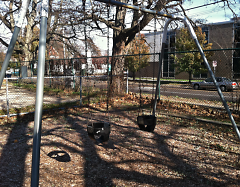Grand Rapids voters passed the Yes! GR Parks proposal on November 5. Though the proposal was passed, money from the millage won't be in until July, 2014. Citizens may want to see changes that will happen in parks quickly, but planning these changes will take a while. Money from the millage will be available starting in July of 2014.
Those first changes will be mostly maintenance that is not highly visible. On September 24, a general guideline for the budget was passed. The budget shows an estimated 45-55% with improvements accounting for 25-35%. Chris Reader on the Grand Rapids Parks and Recreation Advisory Board explains maintenance must happen before any new major investments.
"We just have such a maintenance backlog that we want to focus on fixing broken equipment, getting bathrooms open and the basic stuff we have not been doing as much as we would like," says Reader.
The larger investments and park improvements will take time due to communication with neighborhoods. The first major investments to be made are expected to be based around water resources such as splash pads and pools.
"We have to look carefully when making major investments. For example, the wading pools can't reopen due to the health department. In those places what we would like to do, sooner rather than later is put in those splash pads," says Reader. "A splash pad for a small park like Cherry Park is a pretty major investment. In that case what we would like to do is have a planning session and make sure that we're putting it in the right spot."
Steve Faber, Executive Director of Friends of Grand Rapids Parks, explains that citizens are encouraged to take part in decision-making to help the money go where citizens want it most. During the master planning process next fall, citizens can contact and collaborate with officials.
"We look at it from a continued opportunity to engage the community to determine what projects are chosen and hopefully helping determine what they look like in their own neighborhood," says Faber. "Not every neighborhood park has the resources or the assets that it might really want because the parks haven't had a refresh in a long time. The goal there is not that the City repairs a basketball court that the neighborhood doesn't really want."
Faber and Reader encourage a continued communication with different park planning groups such as Friends of Grand Rapids Parks and the Parks Advisory Board. This can help communicate the needs of citizens and the abilities of the city to work together and make Grand Rapids parks beautiful and useful.
"In order to understand what the neighborhoods want, we want to continue that ongoing dialogue with the community," says Faber. "I know there's a strong commitment from the City to do that."
"We expect to reach out and get the master parks plan done with a lot of citizens involvement," says Reader. "We don't want to build a tennis court when they really want a soccer field. We really want to make sure that we're investing in the right facilities."
The Rapidian, a program of the 501(c)3 nonprofit Community Media Center, relies on the community’s support to help cover the cost of training reporters and publishing content.
We need your help.
If each of our readers and content creators who values this community platform help support its creation and maintenance, The Rapidian can continue to educate and facilitate a conversation around issues for years to come.
Please support The Rapidian and make a contribution today.
